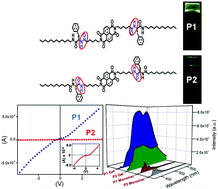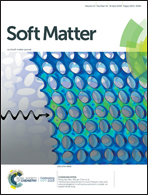Assembly of amino acid containing naphthalene diimide-based molecules: the role of intervening amide groups in self-assembly, gelation, optical and semiconducting properties†
Abstract
Two naphthalene diimide containing molecules, one with a covalently linked peptide (P1) and the other with a covalently attached amino acid residue and a diamine moiety (P2), have been chosen in such a way that the number of intervening amide groups and the centrally located imide moieties are the same, and their molecular formulae are also identical. However, the positions of the amide groups are different in these two molecules and this can dictate a different behaviour in molecular assembly and gelation processes for each of the individual NDI-appended peptide (P1) and pseudo-peptide (P2). The molecule P1 with an attached peptide moiety and the intervening –CO–NH groups forms an organogel in a mixture of chloroform–methylcyclohexane at a very rapid rate and the mechanical strength of the gel is quite high, whereas the molecule P2, containing the amino acid and diamide moieties, and with the intervening –NH–CO groups forms an organogel in a relatively much slower rate in chloroform–methylcyclohexane mixture. The mechanical strength of the P2 gel is significantly lower compared to that of the P1 gel at the same concentration and solvent system. The minimum gelation concentration of P1 is much smaller than that of P2 in the same solvent system. The thermal stability of the P1 gel is higher than that of the P2 gel at the same concentration and solvent system. However, both of these gels form J-type aggregates in a mixture of chloroform–methylcyclohexane with a red shift in the UV-vis spectrum. The gelator P1 exhibits enhanced fluorescence compared to that of P2 at a fixed concentration and in the same solvent system (mixture of chloroform–methylcyclohexane, 5 : 95 (v/v)). The lifetime and quantum yield of the P1 gel are also significantly higher than those of the P2 gel under similar gelation conditions. Moreover, both P1 and P2 are found to exhibit significant semiconducting behaviours in their dried/xerogel states. It is important to note that the stronger gel P1 exhibits relatively better semiconducting behaviour than the weak gel P2. Interestingly, the self-assembly, gelation, photoluminescence and electrical conductivity are different for the gels obtained from these two molecules. This indicates the role of the amide bond and its linkage (whether –CONH/–NHCO) in the self-assembly, gelation and optoelectronic behaviour of these molecules in their assembled states.



 Please wait while we load your content...
Please wait while we load your content...